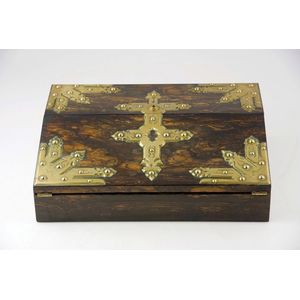George III Satinwood Inlaid Tea Caddy
You must be a subscriber, and be logged in to view price and dealer details.
Subscribe Now to view actual auction price for this item
When you subscribe, you have the option of setting the currency in which to display prices to $Au, $US, $NZ or Stg.
- Canted Corners - In decorative arts, especially furniture making, a canted corner refers to a technique where the corner of the piece is angled or "canted" to create a diagonal corner. This is different from a chamfered corner which is a technique where the edges of a corner are cut at an angle, creating a diagonal edge or "bevel" along the corner.
A canted corner is typically used to add visual interest to the item. It can be found in various styles of furniture such as contemporary, Art Deco, or traditional. It is often used to create a sense of movement and dynamism in a piece.
Canting a corner is a more complex technique than chamfering, and it is typically done by tilting the corner of a piece of furniture and then cutting the wood to match the angle. It's a technique that requires precise measurements and a good understanding of angles and geometry, and it is usually done by experienced artisans. - Satinwood - Satinwood is a dense pale gold coloured timber that was imported into Britain in the second half of the 18th century, and early 19th centuries from the East Indies and the West Indies. The name derives from the satin-like surface sheen when the timber is polished.
It was used in the solid, as a veneer and in inlays. As well as furniture, satinwood was used for making musical instruments, barometers, boxes and clocks.
It will usually be found on only the very best quality objects, presumably because of of its cost at the time. - George Iii - George III (1738 - 1820) was King of Great Britain and Ireland from 1760 to 1820.
This item has been included into following indexes:
Visually similar items

Albert Wolff (1814-1892) bronze figure of an Arab at prayer, alongside a camel, impressed to the base 'Akt-Ges, Gladenbeck, Berlin'

Four Chinese 18th century export blue & white tea bowls, Including matching saucers. Floral and traditional scene decorated. Height 7 cm (each)

Victorian coromandel wood and brass mounted portable writing box the interior fitted with three lidded compartments, pair detachable ink well and pen recess, fall front writing surface with blue velvet lining

John F. Norton attributed (Australia, working 1890's-1930's), Two Tasmanian landscapes, gouache on watercolour on card, 9 x 12 cm each,
